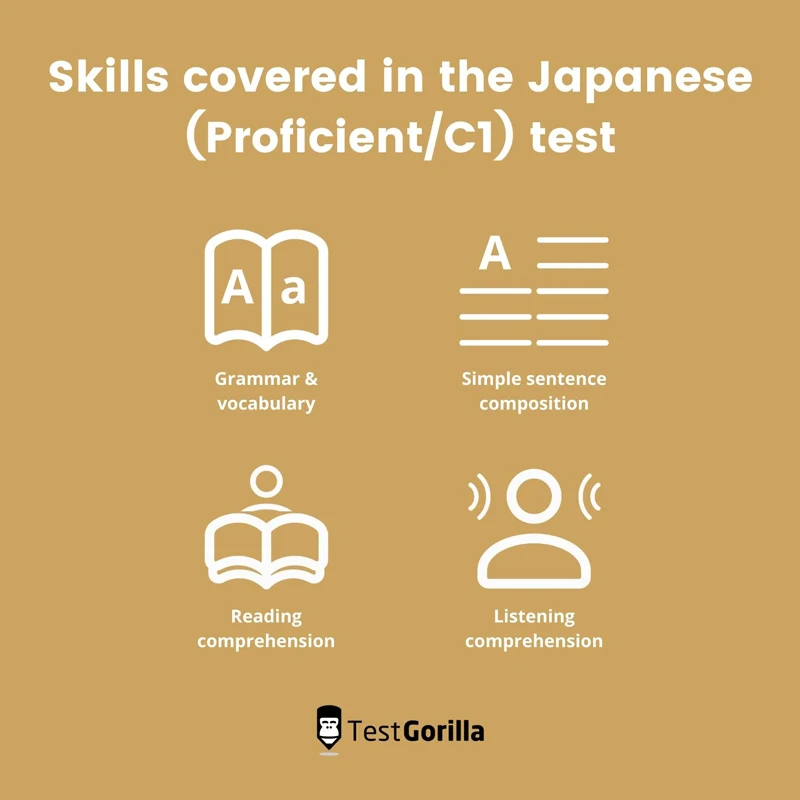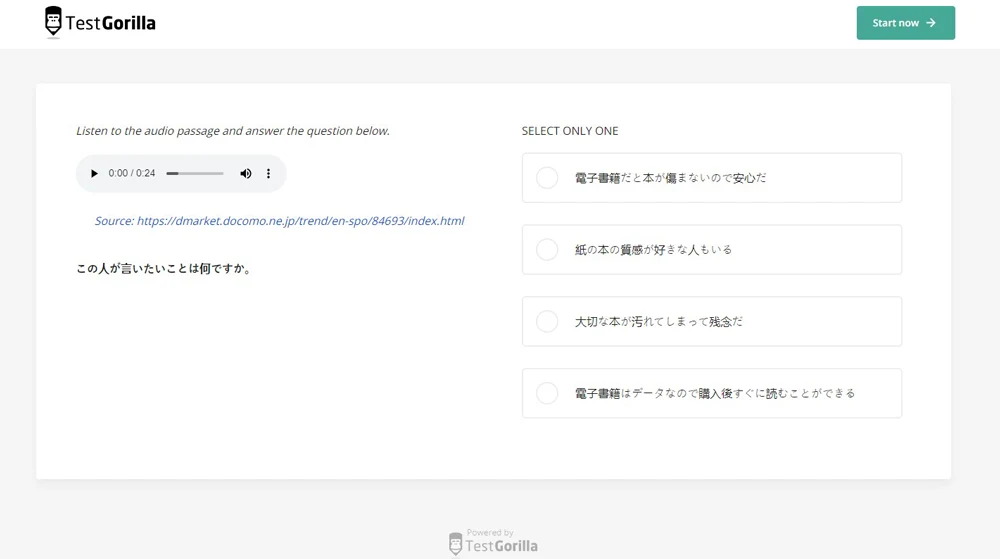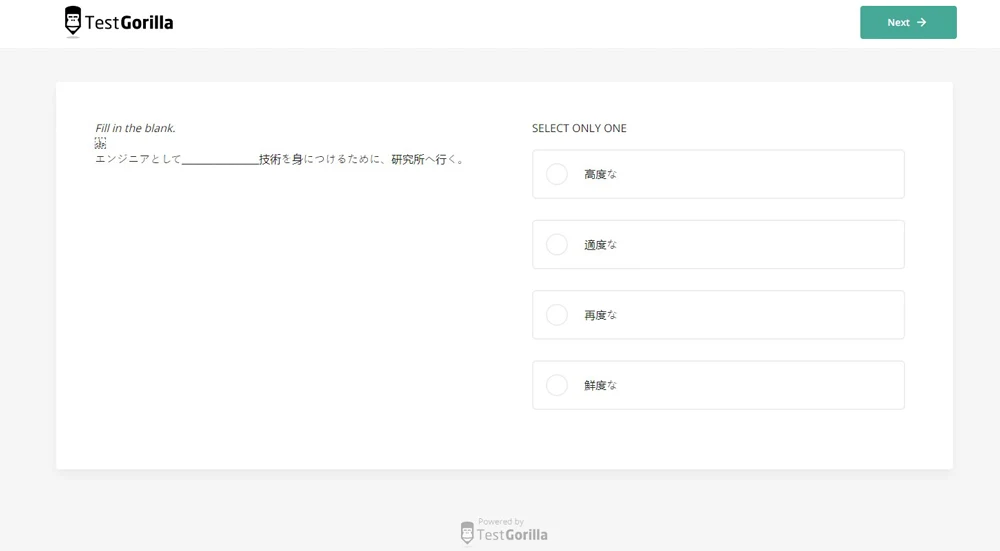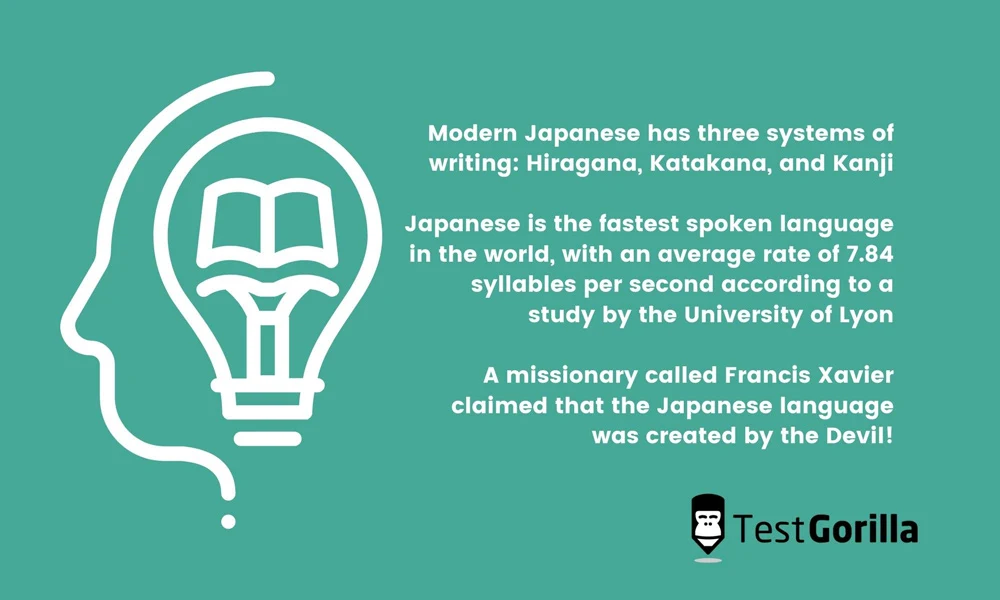If you’re wondering how to go about successfully hiring Japanese language experts when you don’t speak Japanese yourself, don’t worry. Our step-by-step guide will give you all the key information and show you how to use a Japanese language proficiency test to screen candidates.
Did you know that Japanese can be a difficult language to master? It’s ranked by the US Foreign Services Institute as the hardest language for native English speakers to learn. Native Japanese speakers also struggle with learning the English language, so if you’re looking for a skilled Japanese-English translator, they will need to be fluent in both languages.
We’re going to look at what you can do to make hiring a Japanese language expert easier, and how our Japanese language proficiency test can make the whole process faster and worry-free.
First, though, let’s take a quick look at the different frameworks for evaluating skill level in Japanese, and the quickest way to do so.
Table of contents
- CEFR vs BJP and JLPT language tests
- Why it’s easier to use CEFR-based tests for employment screening
- Common reasons to use Japanese language proficiency tests in the workplace
- 1. Decide what level of Japanese language proficiency you require
- 2. Use a Japanese language proficiency test to find skilled candidates
- 3. Combine the Japanese language proficiency test with role-related skills in an assessment
- 4. Draw up an interview shortlist based on test results
- 5. Hire your new Japanese language expert with TestGorilla
CEFR vs BJP and JLPT language tests
There are several recognized Japanese language tests, such as the Japanese Language Proficiency Test (JLPT), the Business Japanese Proficiency Test (BJP), and the Common European Framework of Reference for Languages (CEFR) level-based tests.
The Common European Framework of Reference (CEFR) for languages has a simple-to-understand framework for language proficiency. It’s frequently used by employers in job advertisements to ensure they find staff with the right level of language competence.
The CEFR framework consists of six levels from A1 (beginner) through to C2 (fluent/native speaker level), with each stage representing improved understanding of and fluency in the language. If you want to hire someone with more than just the Japanese language basics, the C1 level is what you should be aiming for.
C1 level Japanese is considered proficient, and those with this skill level can do most jobs that require a more advanced understanding of Japanese.
Those with C1 level Japanese can:
Understand a wide range of demanding, longer clauses, and also recognize implied meaning in Japanese
Express thoughts and ideas fluently without much obvious thinking about it or searching for expressions
Use the Japanese language effectively in social, academic, and professional settings
Produce clear, detailed, and well-structured Japanese text on complex subjects
The only higher CEFR level is C2, which even native Japanese speakers can find difficult to reach.
Why it’s easier to use CEFR-based tests for employment screening
The drawback with many of the other tests such as JLPT and BJP is that they require candidates to attend a test center on specific dates. The JLPT is only available two times a year (July and December), and the BJP frequency differs according to testing centers.
So, while passing these tests means you can ensure that candidates will have the necessary language skills, it is both expensive and inconvenient for you to arrange. The alternative is to search for candidates who already have any of those specific qualifications. That can be time-consuming, though, as you will want to check the validity of their qualifications.
Compare this with using our CEFR C1 level online Japanese language proficiency test. This is done in a cheat-proof environment at any time without your candidates having to leave their home, and without you having to wait days or weeks for results.
You receive results that show you which candidates were the top scorers on the test, and this empowers you with the data to help you decide which ones to take on to the interview stage.
Common reasons to use Japanese language proficiency tests in the workplace
Testing your candidates’ Japanese language proficiency might be necessary in a number of scenarios:
Hiring remotely or hiring employees from abroad
Remote hiring has become more popular over the last few years.
If you want to attract staff from around the world, you must make sure that the Japanese skills of the candidate you select are good enough for them to be efficient at their job and perform well.
Hiring for your company’s offices in a Japanese-speaking country
If your company is currently expanding and you need to hire employees for your offices in a Japanese-speaking country, you ought to check that candidates have the right Japanese skills.
For client-facing positions where the employee will be speaking Japanese
For sales, customer service, tech support, and management roles that require frequent interactions in Japanese, language proficiency will be vital for success.
1. Decide what level of Japanese language proficiency you require
The first step in hiring Japanese language experts is to decide what level of language proficiency the role requires.
Intermediate
The minimum CEFR language proficiency level needed to work successfully at an entry-level job in a different language is B1/intermediate. Those who can speak Japanese at the intermediate level can communicate with customers, colleagues, and others in familiar daily workplace situations and tasks.
They can understand simple sentences on topics that they are knowledgeable about, but they may find it difficult to understand more complex conversations or written text.
B1 level Japanese speakers may struggle when in roles that call for a lot of communication, such as sales, customer service, or supervisory/management roles. They can, however, be successful in retail work, hospitality, agriculture, or factory/warehouse roles.
Proficient
Those who are considered proficient in a language are able to express their thoughts naturally without hesitation or long pauses while they think of the correct word.
They are able to understand longer, more complex text, and know when there is an implied meaning in written or spoken communications. Proficient Japanese speakers are able to use the language easily in social, professional, or academic settings, and they can create detailed texts such as reports and articles.
C1/proficient level Japanese speakers can do most jobs that require a high level of communication. This includes anyone in a customer-facing role, such as sales or customer service, as well as management roles.
If you want to hire a Japanese language translator, then you must be aware that translators only work with the written word (while interpreters work with the spoken word), so their reading comprehension skills must be excellent for accurate translation.
If you want to learn more about translation, check out our post with 10 tips for hiring a translator for your business.
2. Use a Japanese language proficiency test to find skilled candidates
Once you have decided on the level of Japanese language skills needed for the job, your next step is to set up a Japanese language proficiency test to screen candidates. Once you’ve done this, you can write your job description and post your advertisement.
Our Japanese language proficiency test will show you which candidates are at the more advanced level of Japanese, or you can use the Japanese (Intermediate/B1) test if you don’t need such fluent speakers.
Candidates who do well in the Japanese language proficiency test will be able to clearly and effectively discuss ideas, plans, and goals with customers and colleagues. They will also be able to write well-structured reports, presentations, and other written material in Japanese.
Our Japanese language proficiency test will assess a candidate’s ability to communicate at the proficient/C1 level of the Common European Framework of Reference (CEFR) for Languages. This test provides a thorough evaluation in the areas of Japanese grammar and vocabulary, sentence composition, reading comprehension, and listening comprehension.
Below are a couple of sample preview questions from the Japanese language proficiency test to give you an idea of the candidates’ experience. As you can see, these example questions take the form of text and audio:
TestGorilla’s Japanese language proficiency test can be combined with up to five other tests to create a pre-employment assessment.
3. Combine the Japanese language proficiency test with role-related skills in an assessment
You wouldn’t choose to hire a candidate just because they have great Japanese language skills. A bad-tempered and lazy drama queen who speaks fluent Japanese isn’t going to fit well into a team, no matter how much of a language genius they are.
That’s where skills assessments come to the rescue. By combining the Japanese language proficiency test with other technical or soft skills tests at the start of the hiring process, you gain a greater understanding of your candidates’ other strengths and weaknesses.
This enables you to evaluate the test results to see if the applicants align with your expectations, and it gives you further information to create interview questions with.
For example, if you were hiring a Japanese-speaking sales representative, you might decide to add our Salesforce CRM test, Customer Service test, B2C Telesales test, and Communication test to our Japanese (Proficient/C1) test to create an assessment.
It really is up to you which tests you use to build an assessment, and we have a wide range of tests available in our test library. Of course, if you just wish to use the Japanese language proficiency test (or any other test) on its own, that’s fine as well – you’re the boss.
For more information about the test categories we have, the question types, rules, and features, you might find our post on hiring the best with skills assessments a useful read.
4. Draw up an interview shortlist based on test results
Once you have created your assessment or decided on the Japanese language proficiency test you want to use, it’s simple to invite candidates to take the assessment online.
With an assessment, your candidates take all of the tests you have chosen in one sitting. While most candidates wouldn’t dream of cheating, our rigorous anti-cheating measures ensure that candidates aren’t tempted to ask a friend the answers or look them up quickly on Google.
Once the test or assessment is done, you receive the results. Our reports make it easy for you to draw up a shortlist of top-scoring candidates to interview. It’s really that simple, and best of all, there’s not a CV or resume in sight.
5. Hire your new Japanese language expert with TestGorilla
If you’re ready to get started, then our Japanese (Proficient/C1) test is a great foundation to create a pre-employment assessment around.
We know it can be frustrating and time-consuming to find Japanese speakers with the right level of proficiency in the language, but our tests and assessments are designed to make the process fast, fair, and accurate.
Sign up for your free plan now to get started on building your first assessment. There’s no time limit on this plan – it’s free forever, and is a great way to get started with TestGorilla.
If you want more information or to see how our products work first-hand, book a free 30-minute live demo with our sales team, who will be pleased to answer any questions you may have. If you’re ready to dive right in, head over to our pricing page and check out our range of plans to suit all businesses.
Related posts
Hire the best candidates with TestGorilla
Create pre-employment assessments in minutes to screen candidates, save time, and hire the best talent.
Latest posts
The best advice in pre-employment testing, in your inbox.
No spam. Unsubscribe at any time.

Hire the best. No bias. No stress.
Our screening tests identify the best candidates and make your hiring decisions faster, easier, and bias-free.
Free resources
This checklist covers key features you should look for when choosing a skills testing platform
This resource will help you develop an onboarding checklist for new hires.
How to assess your candidates' attention to detail.
Learn how to get human resources certified through HRCI or SHRM.
Learn how you can improve the level of talent at your company.
Learn how CapitalT reduced hiring bias with online skills assessments.
Learn how to make the resume process more efficient and more effective.
Improve your hiring strategy with these 7 critical recruitment metrics.
Learn how Sukhi decreased time spent reviewing resumes by 83%!
Hire more efficiently with these hacks that 99% of recruiters aren't using.
Make a business case for diversity and inclusion initiatives with this data.






















